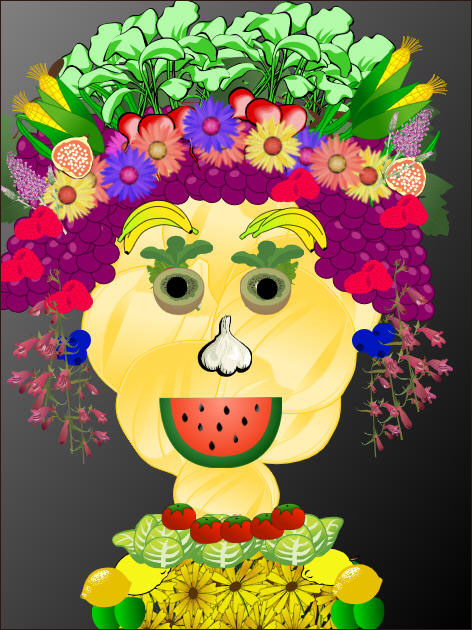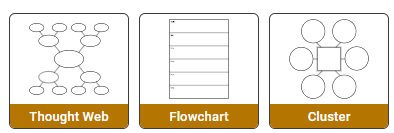50 Activities for Middle School
Hands-on ideas to engage middle school students in meeting standards and learning goals through digital projects.

Using a device to fill out a digital worksheet isn't any more compelling than using a pencil to fill out a paper version. Encourage students to show what they know and capitalize on their interest in technology by creating digital projects on classroom topics using media formats that abound in the world around them.
Explore fifty ideas for using a digital approach to help middle school students meet standards and learning goals, divided into sections for:
Language Arts
Use a digital approach to engage middle school students in reading comprehension and provide authentic opportunities for listening, speaking and writing in narrative, informational and argumentative form.
1. Design a new book cover
Have students create a new cover design for a book they are reading to demonstrate comprehension and explore character, plot, setting, symbolism, and conflict.
Explore a Book Cover Design lesson plan
2. Create a character coat of arms
Small, but mindful, changes can move a task beyond remember and retell. For example, replace a typical character trait cluster assignment with the task of developing a coat of arms for a story's protagonist that represents traits of the main character.
Creating a coat of arms provides students with an opportunity to think about objects, colors, symbols, and mottos that reflect a character's personality, passions, strengths, and experiences.
Wixie has a Coat of Arms template that makes it easy to add color, text, and images to show comprehension.
3. Create a character scrapbook
Ask students to demonstrate knowledge about a character's physical traits, feelings, experiences, and actions by creating a digital scrapbook. Students can include images of important events, diary entries, objects important to the character, letters from friends, and more.
Explore a Character Scrapbook lesson plan
4. Create a Book Trailer
Much like the movie trailers students are familiar with, ask students to create a short, fast-paced book trailer that shares information about characters and events in a way that would motivate others to read the book.
Share the book trailers with the rest of the class or play them on the morning announcements to encourage others to read the books.
Explore a Book Trailer lesson plan
5. Visual Poetry
Blackout Poems
To write a blackout poem, the author covers up words on a page of text until the leftover words form a poem. Digital tools, like Wixie, include blackout poetry templates that contain a page of text from Tom Sawyer (template), Shakespeare (template), Lewis Carroll (template), and more.

Students read the text and circle words they find interesting, then read them again to hear the resulting poem. Students can circle additional words to fill out the idea and then blackout the rest of the words and add additional decoration.
Video Poetry
Poetry's purposeful word choice encourages close, careful reading. Have students create visual versions of poems to demonstrate their comprehension of the author's word choice and intent.
Ask students to create a project and then type a poem from their favorite poet or one they have written, adding stanzas to each page. Students can add illustrations and record themselves reading it.
Explore a Visual Poetry lesson plan
6. Modernize a Myth or Legend
Rather than merely retelling stories, ask students to adapt, extend, or create new versions of the stories they are reading. Students can modernize an ancient myth to make it more relevant to their lives today, comparing similarities and differences along the way.
7. Cool Word Vocabulary
Visuals help form connections to words and help students better remember the meaning of the word.

Digital tools make it easy to combine words and pictures and publish flash cards and posters you can use to improve vocabulary.
Explore a Cool Word Vocabulary lesson plan
8. Publish a personification story
Have students personify an object, and then use a digital tool like Wixie to write, illustrate and publish it as an eBook.
Students should brainstorm feelings the object would have to develop the conflict that will drive their story and begin writing. Scaffold their work further by asking them to identify character traits, determine setting, and codify the plot diagram or at a minimum the beginning, middle, and end.
Explore a Personification Stories lesson plan
Mind maps are a great way to help students scaffold writing. Mind mapping and whiteboarding tools make it easy to brainstorm ideas, then organize them into groups and add connections to show how the ideas are related.
Explore how to use the Mind Map tools in Wixie
9. Craft a Fictitious Interviews
Fiction
Creating a digital story in the form of an interview helps you engage students in writing and makes work with informational text come alive. Ask students to craft fictitious interviews between characters in a novel they are reading to demonstrate comprehension of the traits and behaviors.
Nonfiction
Fictitious interviews are great ways to summarize and deepen comprehension for informational texts as well, making them perfect for science and social studies classrooms. For example, you can ask students to interview a figure from history, an animal, or even an artifact.
More ideas for conducting interviews
10. Product: Wanted posters
Creating a Wanted poster is a great way to get students thinking about the traits, experiences, and motivations of the characters in the stories they are reading.
It is often the antagonist that makes a story interesting or gives a plot direction. Have students create wanted posters for villains in the stories they are reading to evaluate comprehension and help them consider how they might craft a villain to add impact to their own writing.

Creating Wanted posters can also help students clarify their thinking about definitions related to math, atomic elements and molecules, and figures from history.
Math
Digital tools can provide a platform for middle school students to apply mathematical thinking and engage in standards of mathematical practice as they practice procedures, create visual models, and solve problems.
11. Work with Ratio and Rate
Use word problems (ratio and rate) to give students a sense of the ways that ratio and rate connect to the world around them.
Ask students to extend their understanding by writing their own word problems and challenging peers to solve them using strategies like a double-number line.
12. Putt Putt Polygons
Measuring the perimeter and area of polygons requires knowing and applying formulas like the Pythagorean Theorem. Give students a fun context for practicing by asking them to design a hole for miniature golf!
13. Math Backgrounds
Math can be frustrating for some students, especially when erasing mistakes makes equations or coordinate planes unreadable. This problem only adds to the challenge of tackling complex equations and data.
Use backgrounds like grids, plots, or coordinate planes, and have students use paint tools to write equations, fill areas, or plot lines.
14. Design a Dream Home
Ratio and rate also apply to scale in architectural drawings. Even if they don't want to be an architect, most students would love to dream up a bedroom, a tiny house, or even a mansion design.
Have students use a grid to create architectural designs to scale.
15. Play with Probability
You can teach students the rule of probability, but they will retain the information more if they come up with the mathematical rules on their own.
Have students calculate experimental probability by using dice or a specific spinner to do a task 40 times. Have students tally their results and use the data to calculate the experimental probability.
After establishing experimental probability, challenge students to come up with the theoretical probability for other toys. Bonus if they can generate a mathematical model for predicting probability.
16. Collect, analyze, and showcase data
Using data to make predictions, analyze and communicate information is becoming an essential skill for future success. While there are other steps in the data science process, students need to know how to collect and display data in ways that make it easy to visualize and understand.
Wixie makes this process easy with its design tools and templates, whether students are creating bar graphs (categorical), histograms (numerical), or other data displays.
17. Explore Geometric Transformations Through Tessellations
Tessellations are geometric patterns that repeat forever with no gaps or overlaps. Squares can tessellate easily. The word tessellate comes from the Greek word tesseres, which means four.
Inspire students with the work of M.C. Escher or Islamic tiling, and then have them create their own rotation or reflection tessellations.
Explore a Tessellation lesson plan
18. Online Math Academy
Showcase student expertise by asking them to create tutorials to teach others how to calculate, measure, solve and more.
19. Product: Explainer Video
What can your students teach others? Procedural writing is an excellent way for students to become experts in a topic and feel confident about their ability to share the information with others. This process of deconstructing and reorganizing information helps students cement concepts and provides an opportunity for you to pinpoint misconceptions.
So whether students are sharing content, a process they struggled to understand, or something they are passionate about, a how-to assignment is the perfect task to cement learning and inspire others.
20. Inform with Infographics
Have students research information, conduct surveys, or collect data on a topic. Then, students can create charts and graphs, analyze the information, and develop an infographic to display their findings.
Explore a Creating Infographics lesson plan
Science
Digital tools provide a fun way for students to share ideas and explain scientific understandings for Life, Physical, Earth and Space and Engineering concepts.
21. Body System Beats
Ask students to create a music video to inform others about how a body system works, its functions, and how it interacts with other systems for optimal health.
Explore an It's My Body lesson plan
22. Cell Function Similes
Evaluate student understanding of animal cells by asking them to compare how various cell parts, including the nucleus, cell wall, cell membrane, chloroplast, and mitochondria, function like elements on a farm or parts of a school.
By illustrating these comparisons, students not only gain a deeper understanding of cellular structures and their functions but also develop their ability to make meaningful connections between seemingly unrelated concepts.
23. Model Scientific Processes
Actively engage students in scientific exploration by creating simulations and visual representations that model chemical reactions and scientific processes.
By encouraging them to create visual representations, students can deepen their understanding of complex concepts.
24. Expert Interviews
Students can create expert interview videos that delve into scientific concepts and discoveries. By conducting interviews with scientists or experts in the field, students can explore complex ideas and present their findings in an engaging and accessible format; fostering a deeper understanding of science among their peers.
Don't have access to an expert? Craft a fictitious interview!
25. Write Informational Texts
Ask students to create informational science texts to inform or share learning with others. Through these books, students can convey their understanding of various concepts.
26. Terminology Journals
Students benefit from explicit vocabulary instruction, especially terminology linked to a specific discipline or topic. Collecting, defining and refining are easy with digital terminology journals.
27. Animate a Scientific Process
Labeling and diagramming are great, but modeling a process through animation can help students better understand the macro- and micro- scopic processes. For example, ask students to animate a chemical process or geologic cycle, illustrating the stages and processes involved.
Read more about Animating in Secondary Math and Science
28. Connect Physics to Fun
Help students see physics as more than rules and equations by connecting it to a favorite sport or physical activity.
Explore a Fastballs, Free Throws, and Physics lesson plan
29. Publish Informational Comics
Comics and cartoons don't just have to be story-based. These mediums are a great way to share information.
The limited amount of space in a comic's panels requires students to choose key points in a process or important factors in chemical reactions as they work to design and illustrate them.
30. Raise Awareness of Environmental and Health Issues
Students in middle school are starting to have the capabilities and passions to change the world. Have students produce public service announcements (PSAs) to raise awareness, inform, and change behavior.
When developing a public service announcement (PSA), students have a chance to practice and apply persuasive writing skills in a real-world, authentic context. A short PSA targeted at a particular audience also encourages students to focus on writing organization, as well as voice and word choice.
Explore a Here's to Your Health lesson plan
Social Studies
Engaging middle school students in deep thinking about history and community helps to develop citizens who have powerful inquiry and critical thinking skills.
31. Biographies
Using a digital storytelling approach to biographies helps prevent their writing from becoming a list of unrelated facts. Having students combine their research results with imagery, sound, and other media can help them better combine aspects of narrative and informational writing for a more compelling script.
Biographies aren't always books, either. There are even entire cable television channels devoted to biographies. Consider having your students create video biographies, too.
Explore a Video Biography lesson plan
32. Historical Journal
To help students think deeply about how events, circumstances, culture, and leaders in the past affect the lives of human beings, ask students to create a series of fictional journal entries that indicate how events in the past might have affected the life and perspective of a specific person living during that time. (template)
Explore a Historical Journal lesson plan
33. Make a Map
Have students use paint tools and text labels to create maps to show the geographic features, regions, and/or economy of an area, country, or civilization.
34. Produce the News
Our students have grown up watching shows, but not necessarily the news. Challenge your students to develop a news report they would actually want to watch based on the content they are learning.
Writing a news report requires students to organize and summarize information and use new vocabulary and terminology in context.
Explore a News Broadcast lesson plan
35. Interview a Community Leader
Ask students to interview a community member to expand their knowledge and experience, as well as encourage listening, curiosity, and empathy skills.
Encourage students to change the order of questions or the order of the answers shared so that the story "unfolds a lesson learned." In other words, what is the moral of this person's story, or what can it teach the rest of us?
36. Explore Leadership
Students in middle school are idealistic and often passionate about current issues. As they become more aware of civics, rights, and responsibilities in their community, have them explore leadership. What makes a great leader? Who gets to lead?.
Explore a President's Team lesson plan
37. Develop a Virtual Museum
Have students design an online museum, displaying artifacts and stories to engage others in the heritage of their community or a specific region.
Explore a Virtual Museum lesson plan
38. Host a Tourism (Geography) Trade Show
To help students better understand the unique features of a place, have them develop materials for a virtual tourism trade show where students promote and pitch that location to attract visitors.
Explore a Tourism Tradeshow lesson plan
39. Publish a Historical Newspaper
Have students create a newsletter or newspaper to show what they have learned about the events, politics, and cultures of a different time in history.
Newspaper creation helps students better understand the perspectives of those in different times and cultures.
Explore a Day in the Life lesson plan
40. It's a Postcard Point of View
After learning something new, have students tell someone else using a postcard! They could write a postcard from a specific time in history or a unique geographic or cultural destination.
Explore a Postcards from the Past lesson plan
Arts and Social-Emotional Learning
Wixie provides a canvas for students to set goals, explore emotions, and express themselves through art and music.
41. Set SMART goals
The simple act of writing down your goals makes you more likely to achieve them, so have students take some time to set personal goals to accomplish this school or calendar year. Developing goals that are SMART (specific, measurable, attainable, relevant, and timely) can help even more.

Have students use the goals as a home screen on their devices so they see a daily reminder of what they are working to achieve.
Explore a SMART Goals lesson plan
42. Design a Vision Board
A vision board provides inspiration and motivation to reach dreams and goals. Students can choose a goal and add pictures of what they think achieving them looks and feels like.
Digital tools, like Wixie, make it easy to combine images. When vision boards are complete, print or export an image so you can post to a place you are everyday, like on a desk or phone lock screen, for a daily motivator.
Explore a Vision Boarding lesson plan
43. Create an Arcimboldo-inspired self-portrait
Giuseppe Arcimboldo is an Italian Renaissance painter known for his portraits of people that use objects like fruit and books. Challenge students to create Arcimboldo-style self-portraits by combining clip art images in an imaging tool.

Explore an Arcimboldo-Inspired Self-Portraits lesson plan
44. Play Music
While you may not be teaching music theory, expressing one's feelings and emotions through music is both fun and therapeutic. You can try the online keyboard below or give students options like:
45. Write a Classroom Constitution
Involving students in creating a class constitution makes them part of the process of government, giving them a vested interest and responsibility in following and upholding the laws they have determined.
Explore a Classroom Constitution lesson plan
46. Create Surrealist art
Inform students about surrealism. You might inspire them by reading a book like Pish, Posh, Hieronymus Bosch.
Have students use paint tools to illustrate bizarre creatures juxtaposed around a normal self-portrait and then write a poem about the way the surrealism makes them feel.

This example takes advantage of the mirror symmetry options for the paint brush in Wixie.
Explore a Surreal Symmetry lesson plan
47. Explore Collaboration Skills
In All in the Same Boat by Wilkie Martin, a greedy rat is shown how no one wins when success is achieved at the expense of others.

Discuss what makes a great teammate and then ask students to create their own Team Member ID Card to let future group members know a bit about how they work collaboratively.
48. Send a virtual compliment
Show your appreciation for a classmate, family member, or friend with a compliment card. This is a great idea for a random acts of kindness promotion.
Tools like Wixie let you print multiple copies or pages onto a single sheet of paper, making it easy to print, fold, and then drop in a classmate's lunch box or backpack.
49. Make a playlist for your future
Students likely already have playlists for their favorite songs, and many have playlists for different moods. Use this as a jumping-off point to ask them to "audiolize" what their future sounds like by creating a playlist.
Students can add songs they know or create new artists and bands and write descriptions for them.
50. Compose a melody
Use music production or notation software to have students compose their own music.
Have students record themselves singing their melody or playing their compositions on a recorder or keyboard.












